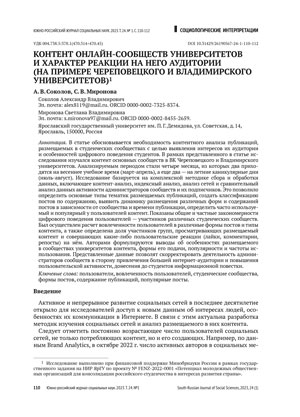Abstract
The article argues the need for content analysis of publications posted in student communities, with the aim to reveal their audience interests and digital behavior patterns. The research presented in this article examines the content of the main VK communities of Cherepovets and Vladimir Universities. The period analyzed was four months, two of which were in the spring school term (March to April) and the other two during the summer vacation time (July to August). The research was based on a comprehensive data collecting and processing methodology. This included content analysis, index analysis, networks analysis and comparative analysis of data on the activities of community managers and their subscribers. As a result, the main themes of posts were established and a classification of posts by content was created. Besides, the dynamics of posting different forms and contents of posts depending on the community and time of publication was revealed, and frequently used and popular content among users was identified. General and specific patterns regarding the digital behavior of users participating in different student communities are illustrated. User involvement in different forms of posts and types of content was calculated, and the proportion of group members viewing the posted content and committing any user reactions (likes, comments, reposts) to it was determined. Conclusions on the characteristics of university communities’ posted content, the way it is presented, and its popularity and frequency of use are drawn by the authors. The data presented will enable the community administrators to adjust their activities in order to attract more Internet audiences and increase user activity, as well as to reach out to students with an information agenda.
Keywords
Funding information
The research was carried out with the financial support of the Ministry of Education and Science of the Russian Federation within the framework of the state contract for the Yaroslavl State University research project / R&D project No. FENZ‑2022-0001 “The potential of youth NGOs to consolidate the Russian student population for the country’s development”.
References
Артамонова, Ю.Д., Володенков, С.В. (2021). Трансформация интернета как пространства общественно-политических коммуникаций: от глобализации к гло(локал)анклавизации. Социологические исследования, 1, 87–97. DOI: 10.31857/S013216250013572-2
Бродовская, Е.В., Домбровская, А.Ю., Лукушин, В.А. (2022). Управление цифровыми коммуникациями с целевыми группами в деятельности ведущих российских университетов. Высшее образование в России, 10, 9–24.
Володенков, С.В., Белоконев, С.Ю., Суслова, А.А. (2021). Особенности структуры информационного потребления современной российской молодежи: на материалах исследования среди студентов-политологов Финансового университета. Вестник Российского университета дружбы народов. Серия: Политология, 1, 31–46.
Все госучреждения в стране будут вести свои странички в социальных сетях (2022). Режим доступа https://1prime.ru/media/20221201/839012806.html
Манжосов, А.Е. (2018). Вовлечение потребителя в процесс создания ценности путем использования инструмента кастомизации и в сети Интернет. Экономика: вчера, сегодня, завтра, 3А, 300–307.
Мартьянов, Д.С., Мартьянова, Н.А. (2019). Управляемость виртуальных сообществ: сравнительный анализ политизированных групп Вконтакте. Журнал политических исследований, 3, 79–93.
Социальные сети в России: цифры и тренды, осень 2022 (2022). Режим доступа https://br-analytics.ru/blog/social-media-russia‑2022/
Эффективность присутствия вузов России в соцсетях (2020). Режим доступа https://vc.ru/social/167719‑effektivnost-prisutstviya-vuzov-rossii-v-socsetyah
Bayram Özdemir, S, Stattin, H, Özdemir, M. (2016). Youth’s Initiations of Civic and Political Discussions in Class: Do Youth’s Perceptions of Teachers’ Behaviors Matter and Why? Journal of Youth and Adolescence, 45(11), 2233–2245. DOI: 10.1007/s10964-016-0525‑z
Bucher, T. (2018). If... Then. Algorithmic Power and Politics. Oxford: Oxford University Press.
Diamond L. (2019). The Road to Digital Unfreedom: The Threat of Postmodern Totalitarianism. Journal of Democracy, 30(1), 20–24. DOI: 10.1353/jod.2019.0001
Douwes, R., Stuttaford, M. and London, L. (2018). Social Solidarity, Human Rights, and Collective Action: Considerations in the Implementation of the National Health Insurance in South Africa. Health and Human Rights, 2, 185–196.
Rehg, W. (2007). Solidarity and the Common Good: An Analytic Framework. Journal of Social Philosophy, 38(1), 7–21.
Reynolds, L., Sariola S. (2018). The ethics and politics of community engagement in global health research. Critical Public Health, 28(3), 257–268.
Wonneberger, A., Kim, S.J. (2017). TV News Exposure of Young People in Changing Viewing Environments: A Longitudinal, Cross-national Comparison Using People-meter Data. International Journal of Communication, 11(1), 72–93.


